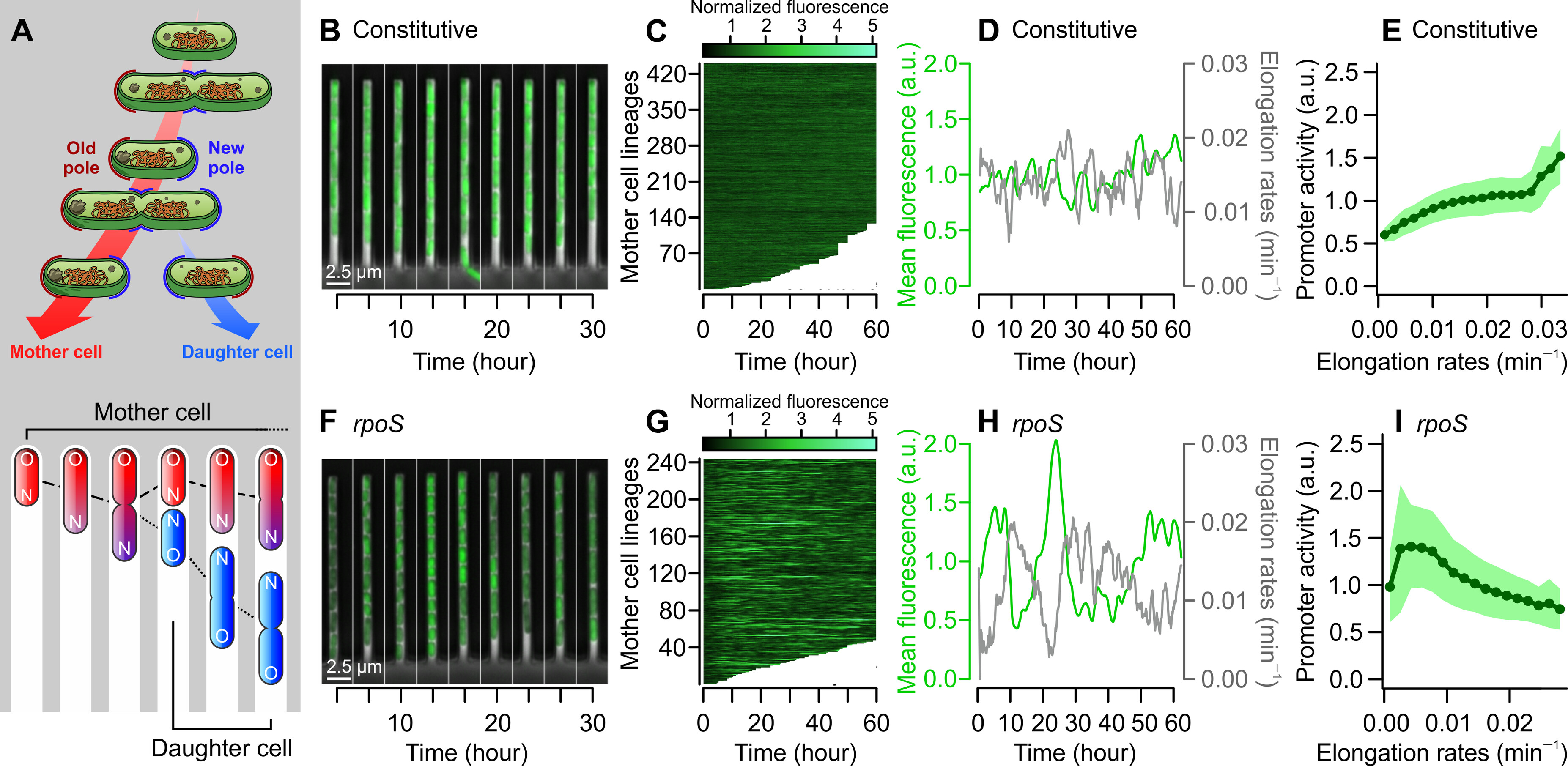博文
细胞水平衰老的新视角
 精选
精选
||
细胞水平衰老的新视角
诸平
Fig. 1. Gene expression stochasticity and correlation with growth demonstrate contrasting promoter dynamics
据德国柏林自由大学(Free University of Berlin / Freie Universitaet Berlin)2024年11月11日提供的消息,细胞水平衰老的新视角(A New Perspective on Aging at the Cellular Level)。
由柏林自由大学的生物学家乌尔里希·施泰纳(Ulrich K. Steiner)博士领导的一组研究人员进行的一项研究中,出现了关于细菌衰老的惊人发现。相关研究结果于2024年11月8日已经在《科学进展》(Science Advances)杂志网站发表——Audrey M. Proenca, Murat Tuğrul, Arpita Nath, Ulrich K. Steiner. Progressive Decline in Old Pole Gene Expression Signal Enhances Phenotypic Heterogeneity. Science Advances, 2024, 10(45). DOI: 10.1126/sciadv.adp8784. Pub Date: 8 Nov 2024. https://doi.org/10.1126/sciadv.adp8784
在此论文中,研究小组证明,即使是生活在相同环境中的基因相同的细菌细胞,对衰老过程的反应也不同,细胞不同区域的变化速度也不同。这项研究不仅促进了科学家对衰老潜在机制的理解,而且还可以为研究细菌活力和对环境影响以及抗生素的耐药性提供方法。
“在过去的150年里,人类的预期寿命一直在以每年约3个月的速度持续增长。然而,我们对衰老的机制仍然只有初步的了解,”该研究的第一作者奥黛丽·普罗恩卡博士(Dr. Audrey Proenca)解释说。像细菌这样的单细胞生物在很长一段时间里被认为是“不朽的”("immortal")。因为细菌可以分成相等的两部分,而且细菌菌株可以无限地延续下去,科学家们过去认为细菌不会老化。然而,最近的研究表明,当涉及到细菌衰老过程时,存在着令人难以置信的可变性。
即使是在相同的环境中,一般相同的细胞也会表现出不同的行为,有些细胞生长得更快,有些细胞产生大量其他细胞根本没有的某些蛋白质。为了了解细菌细胞的衰老动力学,科学家们必须更仔细地观察这些细胞。
对细胞衰老的新认识(New Insights into Cell Aging)
柏林自由大学的进化人口学研究小组(The Evolutionary Demography research group)调查了100多代大肠杆菌的行为和衰老动态。
奥黛丽·普罗恩卡博士说:“我们发现了细菌衰老的一个新方面,它展示了单个细菌细胞的衰老过程是如何发生的。”虽然大肠杆菌(E. coli)的母细胞和子细胞看起来是一样的,但是每个母细胞都保留了一个“老极”("old pole")——杆状细胞的更老的一端——并将一个“新极”("new pole")传递给子细胞。在荧光蛋白的帮助下,研究小组观察到母细胞的“老极”是如何随着年龄的增长而变暗的,这表明随着时间的推移,它们产生的新蛋白质越来越少。在子细胞中没有发现同样的效果。“母细胞和子细胞之间的不对称性随着时间的推移而增加,这反过来表明细菌不会对称地分裂和衰老,”奥黛丽·普罗恩卡博士解释说。
研究小组负责人乌尔里希·施泰纳博士补充说:“我们也惊讶地发现,这种衰老过程发生在母细胞的两极之间。”
这些研究结果对于更好地理解单细胞生物的衰老和细胞异质性具有重要意义。这项研究表明,衰老如何增强单个细菌种群的异质性。它还可以为人类细胞如何衰老以及如何对抗与年龄有关的疾病提供重要的指示。此外,它还为研究细胞活力和抗应激、抗抗生素的机制开辟了新的视角。
这项工作得到了柏林自由大学新星博士后奖学金(Rising Star Postdoctoral Fellowship, Freie Universität Berlin)、亚历山大·冯·洪堡基金会洪堡研究奖学金(Humboldt Research Fellowship, Alexander von Humboldt Foundation)、德国研究基金会(German Research Foundation grant 430174701)、玛丽居里学者欧洲博士后奖学金(Marie Skłodowska-Curie Actions’ European Postdoctoral Fellowship grant 101069035)、德国研究基金会海森堡计划(Heisenberg Programme of the German Research Foundation grant 430170797)的资助。
上述介绍,仅供参考。欲了解更多信息,敬请注意浏览原文或者相关报道。
Cell growth and gene expression are heterogeneous processes at the single-cell level, leading to the emergence of multiple physiological states within bacterial populations. Aging is a known deterministic driver of growth asymmetry; however, its role in gene expression heterogeneity remains elusive. Here, we show that aging mother cells undergo a progressive decline in old pole activity, generating asymmetry in protein partitioning, gene expression, and cell morphology. We demonstrate that mother cells, when compared to their daughters, exhibit lower product inheritance and gene expression rates independently of promoter dynamics. The declining activity of maternal old poles generates gene expression gradients that manifest as mother-daughter asymmetry upon division, showing that asymmetry is progressively built over time within the maternal intracellular environment. Moreover, old pole aging correlates with a gradual increase in cell length, leading to morphological asymmetry. These findings provide further evidence for aging as a mechanism to enhance phenotypic heterogeneity in bacterial populations, with possible consequences for stress response and survival.
https://blog.sciencenet.cn/blog-212210-1459749.html
上一篇:数据可以存储在塑料中吗?
下一篇:代谢酶走向核,为突破性的癌症治疗铺平道路
